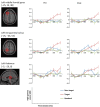High-gamma power changes after cognitive intervention: preliminary results from twenty-one senior adult subjects
- PMID: 26855826
- PMCID: PMC4733105
- DOI: 10.1002/brb3.427
High-gamma power changes after cognitive intervention: preliminary results from twenty-one senior adult subjects
Abstract
Introduction: Brain-imaging techniques have begun to be popular in evaluating the effectiveness of cognitive intervention training. Although gamma activities are rarely used as an index of training effects, they have several characteristics that suggest their potential suitability for this purpose. This pilot study examined whether cognitive training in elderly people affected the high-gamma activity associated with attentional processing and whether high-gamma power changes were related to changes in behavioral performance.
Methods: We analyzed (MEG) magnetoencephalography data obtained from 35 healthy elderly subjects (60-75 years old) who had participated in our previous intervention study in which the subjects were randomly assigned to one of the three types of intervention groups: Group V trained in a vehicle with a newly developed onboard cognitive training program, Group P trained with a similar program but on a personal computer, and Group C was trained to solve a crossword puzzle as an active control group. High-gamma (52-100 Hz) activity during a three-stimulus visual oddball task was measured before and after training. As a result of exclusion in the MEG data analysis stage, the final sample consisted of five subjects in Group V, nine subjects in Group P, and seven subjects in Group C.
Results: Results showed that high-gamma activities were differently altered between groups after cognitive intervention. In particular, members of Group V, who showed significant improvements in cognitive function after training, exhibited increased high-gamma power in the left middle frontal gyrus during top-down anticipatory target processing. High-gamma power changes in this region were also associated with changes in behavioral performance.
Conclusions: Our preliminary results suggest the usefulness of high-gamma activities as an index of the effectiveness of cognitive training in elderly subjects.
Keywords: Behavioral performance; cognitive intervention; elderly; high‐gamma activity.
Figures



Similar articles
-
Effects of Different Types of Cognitive Training on Cognitive Function, Brain Structure, and Driving Safety in Senior Daily Drivers: A Pilot Study.Behav Neurol. 2015;2015:525901. doi: 10.1155/2015/525901. Epub 2015 Jun 16. Behav Neurol. 2015. PMID: 26161000 Free PMC article. Clinical Trial.
-
High-gamma activity in an attention network predicts individual differences in elderly adults' behavioral performance.Neuroimage. 2014 Oct 15;100:290-300. doi: 10.1016/j.neuroimage.2014.06.037. Epub 2014 Jun 21. Neuroimage. 2014. PMID: 24960420
-
Changes in Resting-State Brain Activity After Cognitive Behavioral Therapy for Chronic Pain: A Magnetoencephalography Study.J Pain. 2024 Aug;25(8):104523. doi: 10.1016/j.jpain.2024.104523. Epub 2024 Apr 4. J Pain. 2024. PMID: 38582288
-
Neural correlates of changes in a visual search task due to cognitive training in seniors.Neural Plast. 2012;2012:529057. doi: 10.1155/2012/529057. Epub 2012 Sep 17. Neural Plast. 2012. PMID: 23029625 Free PMC article. Clinical Trial.
-
[Cognition, schizophrenia and the effect of antipsychotics].Encephale. 2006 May-Jun;32(3 Pt 1):341-50. doi: 10.1016/s0013-7006(06)76162-0. Encephale. 2006. PMID: 16840928 Review. French.
Cited by
-
Prognostic Factors and Models for Changes in Cognitive Performance After Multi-Domain Cognitive Training in Healthy Older Adults: A Systematic Review.Front Hum Neurosci. 2021 Apr 27;15:636355. doi: 10.3389/fnhum.2021.636355. eCollection 2021. Front Hum Neurosci. 2021. PMID: 33986652 Free PMC article.
-
Hybrid framework of fatigue: connecting motivational control and computational moderators to gamma oscillations.Front Neuroergon. 2024 May 28;5:1375913. doi: 10.3389/fnrgo.2024.1375913. eCollection 2024. Front Neuroergon. 2024. PMID: 38864094 Free PMC article.
References
-
- Akimoto, Y. , Nozawa T., Kanno A., Ihara M., Goto T., Ogawa T., et al. 2014. High‐gamma activity in an attention network predicts individual differences in elderly adults' behavioral performance. NeuroImage 100:290–300. - PubMed
-
- Aron, A. R. , Monsell S., Sahakian B. J., and Robbins T. W.. 2004. A componential analysis of task‐switching deficits associated with lesions of left and right frontal cortex. Brain 127:1561–1573. - PubMed
-
- Bamidis, P. D. , Vivas A. B., Styliadis C., Frantzidis C., Klados M., Schlee W., et al. 2014. A review of physical and cognitive interventions in aging. Neurosci. Biobehav. Rev. 44:206–220. - PubMed
Publication types
MeSH terms
LinkOut - more resources
Full Text Sources
Other Literature Sources
Research Materials

